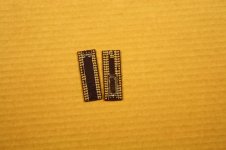Dwight Elvey
Veteran Member
Hi Dave
It is funny that I'd originally bought a 74138 with intentions
of using that. When I started the drawing I couldn't recall why I'd
bought it.
I still need an inverter for the R/W on the EEPROM or I'll not be able
to do in place programming. I'd really like to keep that.
I just realized that K6/7 is OK for reading but needs CLK2 for writes.
I have some cleanup to do.
Dwight
It is funny that I'd originally bought a 74138 with intentions
of using that. When I started the drawing I couldn't recall why I'd
bought it.
I still need an inverter for the R/W on the EEPROM or I'll not be able
to do in place programming. I'd really like to keep that.
I just realized that K6/7 is OK for reading but needs CLK2 for writes.
I have some cleanup to do.
Dwight
Last edited:




